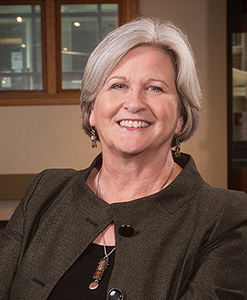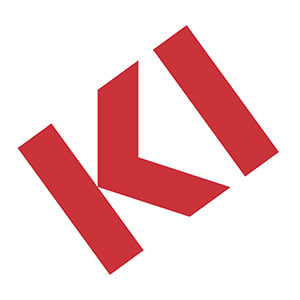A Conversation with IIDA’s Educator of the Year: Katherine Ankerson

We can never thank our teachers enough for the impact they have on our lives. This year in particular, our educators have overcome remarkable challenges to keep inspiring and guiding us.
KI is proud to sponsor the 2020 IIDA Educator of the Year Award, which recognizes and celebrates a full-time design educator for outstanding accomplishments and commitment to interior design education. We were honored to present the award in June to Katherine Ankerson, dean of the College of Architecture at the University of Nebraska-Lincoln.

We recently spoke with Katherine about her career as an educator, the future of design education and her advice for recent graduates. This conversation has been lightly edited for clarity.
KI: What inspired you to enter a career in design education?
Katherine Ankerson: It was a bit of serendipity that I entered design education in the first place. I lived near Washington State University and after one professor left, the school reached out and asked if I would teach a class. I’ve always felt that it was important to mentor others. Teaching creates opportunities to affect young people. When you’ve done that, you shape the future.
KI: How did your educational experience shape the way you teach now?
Ankerson: I took the experiences from the really wonderful professors I had -- those who pushed me to explore beyond my comfort zone and respected the unique approaches that each student brought. There were also experiences on the other side of the spectrum -- things I vowed never to do when I became a teacher.
KI: When you were appointed dean of the University of Nebraska-Lincoln College of Architecture, you noted that you believe in embracing new technologies as well as traditional design tools. What does that look like for you? Do you have advice for other students or educators who want to do the same?
Ankerson: Embracing new technology and traditional design tools means using all of the tools, regardless of where they fall on that spectrum of technology. Your process might use high-tech analytic tools, graphic exploration tools, 2D or 3D modeling, digital screens or trace paper. Each one unlocks different approaches, and the synergy between them allows for new ways of thinking. My advice is not to think of something as digital or analog but to think about the process or problem before you and put every tool you have on the table. Go at it from every direction.
KI: At IIDA’s Design Leaders Celebration, you mentioned the importance of inclusivity and diversity in the design industry. What does that look like for you and how are you working to improve inclusivity in design?
Ankerson: There’s no doubt that the design profession struggles with underrepresentation, and education is the same way. Awareness is the first step, including increasing our understanding of implicit bias. We need to communicate about design as a right for everybody, rather than a privilege for an elite few. As society understands more about the expectation of good design for all, then we can bring increased attention to design as a valuable career path.
This year, our entire lecture series at UNL’s College of Architecture will focus on designing and planning for a just society. It will get into how design has excluded people of color and under-served groups, not only in the design process but in design outcomes.
We’re also taking steps in the college to do a sort of cultural survey -- to explore where are we now with our own attitudes; how that affects the staff, faculty and students; and what our steps forward are.
KI: What does design equity mean to you?
Ankerson: Design equity is about the importance of inclusivity in design industries. The key underpinnings to achieve design equity are honesty, mutual respect, openness and understanding.
One way to explore the concept of design equity is to look at the differences between populations who can afford design services and those who cannot. If you walk into a retail or college environment, that space has been purposefully designed. Elsewhere in our world, there are examples that haven’t received the same design attention to support life, society or community.
The more we know about design’s impact, the more we can help people heal, learn and thrive. This knowledge that we build goes hand in hand with a moral imperative to put that into effect for everyone.
KI: When the pandemic hit, how did you adapt to virtual teaching? Have there been any silver linings or challenges?
Ankerson: I feel so fortunate that at our university, we had two weeks to pivot to distance learning. That gave faculty a chance to reflect on their current courses and determine what objectives and goals from the class still needed to be met.
One silver lining was that we ended up having conversations college-wide, across disciplines about what challenges students were facing and arrived at potential solutions to those.
One of the best parts about the switch was that faculty who had never taught online had their eyes opened to some aspects of online learning than might be better than in-person learning. Students can go back and re-watch videos to learn a new concept, for example.
I would say that the biggest challenge is building and maintaining the sense of culture and community. During that immediate pivot, we had faculty and staff reaching out to students who went home to rural areas to make sure they had internet access. We would triage to come up with quick solutions for students: sometimes financial, sometimes internet-related and sometimes the challenges of being thrust back into a family situation.
KI: Do you think the pandemic will result in long-term changes to design education, either to your own teaching style or the field as a whole? If so, how?
Ankerson: I do. At UNL, we’ve been exploring the goals of courses and how students can best learn the material. We consider what’s best to have online for students -- maybe a video of drawing or a tutorial to learn a program -- so they can access it whenever and however many times they want to. As well, we are utilizing digital tools for studios and the interactive reviews so integral to the process.
We also have a new sense of appreciation for in-person interaction and elevating that experience!
For the future of design education, we’re focusing on teaching emotional intelligence and social impact, which are important when we talk about a sense of justice in design. I expect there will be more emphasis on creating agile, resilient and optimistic graduates.
KI: What about design itself? Will the pandemic impact the design process and the intention behind it?
Ankerson: Undoubtedly, design is going to change. We really have to look at trends that are happening, including artificial intelligence, evidence-based design, value-based approaches to the business of design, computation, robotics and changes to various sectors. Each of those things on their own can create change in the design process.
When you take all of those things together, we are truly at a remarkable and pivotal time that is heightened by the COVID pandemic. Our college mission statement includes, “We create a healthy, beautiful, resilient world.” I can’t think of a better time to focus on those three attributes.
KI: Given the impact of the pandemic, what are some of the biggest challenges recent graduates and soon-to-be graduates will face as they enter the workforce?
Ankerson: Finding a position is a normal challenge for graduates. Depending on the geographical area and what happens with the economy, hopefully the biggest challenge won’t be finding that position. Many firms I’ve talked to are very busy with a robust workload while others have definitely slowed down.
The rapid rate of change is another challenge. Are students prepared for that? I think they’re well-positioned based on their education and the world they’re living in. They have the opportunity to think differently and put their education to work in ways they perhaps hadn’t imagined.
What an exciting time to be in the design profession. I can’t think of any other profession that’s better positioned to manage this change and make positives attributes come of that change.
Challenges? Yes. Exciting opportunities? Absolutely.
KI: You have over 30 years of experience in design education. Are there any lessons you learned along the way that you want to pass along to the next generation of designers and design educators?
Ankerson: Respect and an openness to learning throughout one’s life and career are so important. Each person brings something unique to a situation. As educators, it’s our responsibility to find out what that is, empower it and celebrate the synergy that it brings to the situation. Encouragement can never be too overrated.
KI: Is there anything else you would like to add?
Ankerson: I am appreciative of all the excellent educators we have in our field. These people are professionals and they care deeply -- not only about their students but the knowledge they’re imparting and the impact those students are going to have on the world. Educators are a remarkable group of people.
Subscribe
Stay up to date with the latest trends and more.
